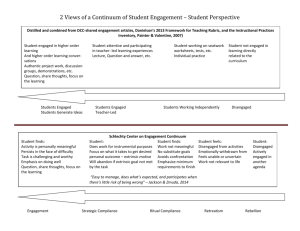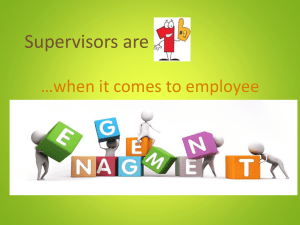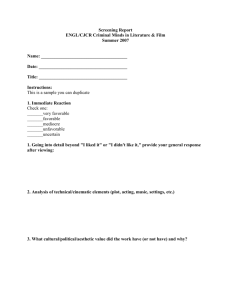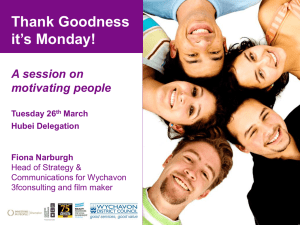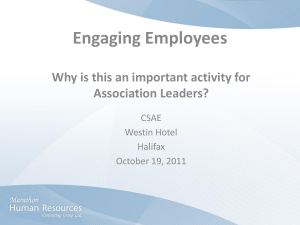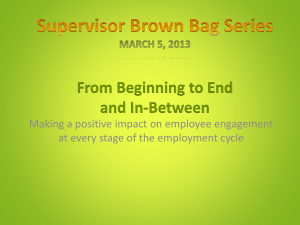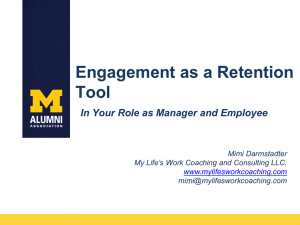8 Tips to Engage Your Employees
advertisement
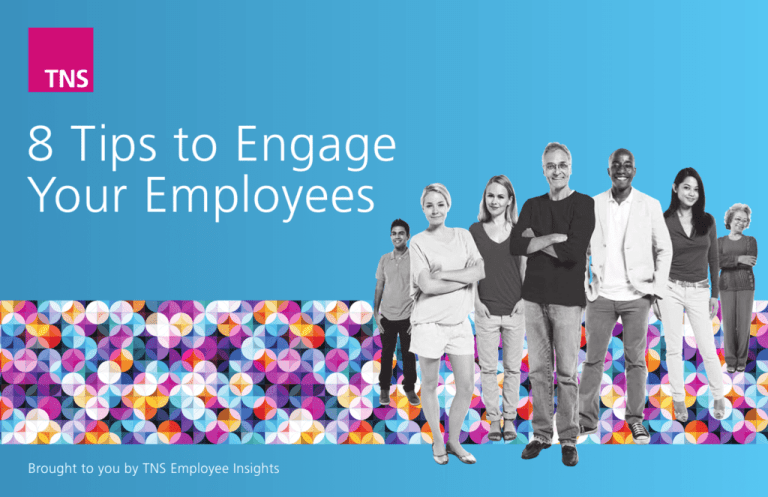
8 Tips to Engage Your Employees Brought to you by TNS Employee Insights Tips 01 Get to Know Your Employees. . .....................................4 02 Provide Basic Training for Your Employees. . ...................6 03 Develop Your People...................................................8 04 Recognize Your Employees.. ....................................... 10 05 Encourage Teamwork................................................ 12 06 Build a Customer Focused Team................................. 14 07 Coach Your Employees.............................................. 16 08 Act on Employee Feedback........................................ 18 Improve Employee Engagement – One Tip at a Time This booklet is designed for managers as an easy guide to improve employee engagement. Filled with tips and best practices for increasing engagement among your work teams, this book provides practical guidance for managers based on real results from our research with some of the world’s leading organizations. TNS surveys millions of employees each year. We help some of the world’s greatest companies become the best in their industry and support them in their quest of becoming a high performance organization. High performing companies are made up of high performing leaders who engage their people to ensure that their customers receive exceptional service. Feel free to use these tips to further engage your employees. You’ll be amazed at how implementing these leadership tips can really improve the engagement and performance of your employees and teams. If you would like to order more copies of this booklet, or learn about our global employee survey or predictive HR analytic capabilities please visit: www.tips.tnsei.com or call 888.726.8686. Tip #01 Get to Know Your Employees Take time to listen and learn about your employees’ interests. This helps build relationships between employees and managers and can have an important impact on employee motivation and engagement. Best Practices Spend time to learn more about your employees. Managers who take time to understand the backgrounds and values of their employees will see greater impact on employee attitudes and motivation, developing stronger connections to their employees. about employee leisure activities can go a long way. Take time to ask questions about the general well-being of family members. Ask how an employee’s hobbies or leisure activities are going. The simple act of asking demonstrates to employees you truly care about them as individuals. Since a large portion of an employee’s life is spent at work, take the time to know what’s important to your employees outside of work. Demonstrate in small ways that you care about their well-being. Listening and learning about your employees is an easy way to demonstrate that you care and want to know more about them as a person. This behavior by managers can have a positive impact on employee attitudes and motivation and strengthen the relationship between the two. For example, some employees will share knowledge of their families or provide insight into their out-of-work activities. As a manager, remembering the names of an employee’s family members or retaining information 4 is in h ! f o ro searc p e th ns re Highly engaged employees respond much more t e h favorably to the question, “My supervisor cares about t me as a person,” than disengaged employees. 83% OF HIGHLY ENGAGED EMPLOYEES 4% OF DISENGAGED EMPLOYEES 5 Tip #02 Provide Basic Training for Your Employees Provide your employees with proper job training to help them excel in their career. Ensuring employees complete tasks accurately helps them achieve goals and provides motivation which leads to higher levels of engagement. Employees are more engaged when they understand their roles and responsibilities within their position. And, an understanding of job responsibilities results in higher levels of performance and commitment to your organization. Best Practices Provide employees with basic training. If an employee is having a difficult time with a particular task, offer additional training or coaching sessions to provide further clarification and education. Provide regular feedback to employees so they can improve in areas of opportunity and continue to excel at their strengths. Consider pairing a mentor or coach with your new employees. Ask the mentor to regularly check in with a new employee to ensure that they understand all 6 aspects of their role, and to cover any questions that may come up during different assignments. The mentor should document major milestones and share successes with the new employee to encourage their ongoing development. As a manager, don’t forget to provide ongoing feedback and training for employees as they assume greater job responsibilities. When your employees receive training and fully understand their role in the organization, their motivation will increase, as will their engagement and success in your organization. TNS global research shows that highly engaged employees have a clearer understanding of their job responsibilities and receive the proper training to do a quality job. Highly engaged employees respond 96% favorable to the question, “I have a very clear idea of my job responsibilities,” vs 37% favorable for disengaged employees. 96% 37% Highly engaged employees respond 83% favorable to the question, “I have received the training I need to do a quality job,” vs 12% favorable for disengaged employees. 83% is in ! f o o r the p research ns the t 12% Tip #03 develop Your people Developing your people is important to your success as a manager. Opportunities for growth and development are a key driver of employee engagement as well as organizational success. Employees who grow and develop their skills are more likely to stay with a company and recommend the company to others. This helps the overall company build the talent and teams needed to be successful. Best Practices As a manager, allow employees to job shadow and learn about other roles within their department. Look for opportunities for your employees to take on special projects or work on additional assignments outside of their day to day role. Support their efforts by providing time in their schedule to take on these projects. Providing external development opportunities is also important. Opportunities for growth and development are a key driver of employee engagement as well as 8 organizational success. These may include programs focused on skills training provided, tuition reimbursement for external continuing education courses, and leadership development programs. Don’t forget to link training and development programs to strategic goals. When employees understand how their development links to business goals, they are more connected to the organization. TNS research shows that top work groups score higher on providing opportunities for growth compared to bottom work groups. isor takes “My superv terest in an active in d career my skills an t.” developmen d core s ps s u o r ersu g ble v Top a r o m fav otto 76% or b f ps. 58% grou k r wo Top w ork gr oups score 81% favora versus ble 67% for low work group s. 81% 67% f is in ! o o r p e th rch a e s e r s the tn 76% 58% “I am satisfied with my opportunities for development.” 04 Recognize Your Employees Recognition from a manager is a very important motivator for employees. It encourages positive behavior and helps promote long-term top performance. Best Practices As a manager, you must understand what forms of recognition motivate your employees. For instance, recognition can be delivered in monetary and nonmonetary forms. Most employees prefer to receive frequent recognition throughout the year. A ‘thank you” or “nice job” can go a long way. Make sure to highlight an employee’s recent accomplishments on a project during a company town hall meeting, or set up an online bulletin board where fellow employees can post ‘thank you notes’ to show their appreciation. Make recognition easy and highly visible to everyone throughout the organization so that others can share in the acknowledgement. 10 Recognition should be simple and should occur as often as possible. There is no limit to how much recognition can be delivered and it is important that it come from multiple sources (i.e., senior leadership, immediate supervisors, peers and clients). Employees from different generations may value recognition in different ways. For example, millennial employees may appreciate on-demand feedback and instant recognition, while baby boomers or gen-x employees may appreciate a more discreet form of recognition. Perhaps seek them out for guidance because of their expertise in a particular area. Recognition promotes positive behaviors and attitudes in the workplace, and in turn, promotes higher levels of employee engagement. s inch! i of ar o r ese p e th tns r Highly engaged employees respond 83% e favorable to the question, “How satisfied th are you with the recognition you receive for doing a good job,” vs only 3% favorable for disengaged employees. 83% OF HIGHLY ENGAGED EMPLOYEES OF DISENGAGED EMPLOYEES Tip #05 Encourage Teamwork Teamwork grows out of a culture of openness and trust between managers and employees. When employees feel they are part of a team within their company, they invest more time and energy into their job. Best Practices Teamwork fosters a cooperative atmosphere where employees have a positive attitude about the job and also ensures greater efficiency. As a manager, instill a “we’re in this together” spirit among your team. Sharing important company information, newsworthy updates from client meetings, or providing a summary of recent meetings ensures that the team is aligned toward the same goals. confidence in other members of their team, when they know their discretionary help will be reciprocated and when everyone believes the work is fairly distributed. Promote teamwork by recognizing employees who are willing to help others by stepping outside of the official requirements of the job. Create channels where peers can recognize each other and show appreciation for this kind of help. When coworkers trust each other and rely upon each other to Cooperation within the team and across work groups accomplish tasks more efficiently, they are more likely to be also eliminates duplicate efforts and costly errors. engaged at work and less likely to leave. Employees cooperate with each other when they have 12 n of is i h ! o r p the arc e s e r s the tn Highly engaged employees’ score of 92% favorable versus 5% for disengaged employees. OF HIGHLY ENGAGED EMPLOYEES “People in my departm ent work tog ether as a team .” OF DISENGAGED EMPLOYEES “Coming together is a beginning. Keeping together is progress. Working together is success.” - HENRY FORD 13 06 Build a Customer Focused Team Today’s best leaders, managers and employees are customer-focused. They understand and anticipate the needs of both internal and external customers. They meet and exceed customer needs with timely, efficient and economical solutions. Best Practices Meet with your team and assess whether your department has the resources necessary to meet customer expectations. Evaluate your department’s customer response time by seeking both team and customer input. Make sure your team understands what customers should receive priority (time and resources). Conduct periodic meetings with internal and external customers to discuss their unique challenges and the ways your team can be more supportive. Invite your employees to participate in the meetings. Develop and 14 ask a brief set of questions to assess their satisfaction with your department’s services. Share the results with your team and develop action plans to improve customer relationships. Ask your employees to keep a log of ideas to improve customer service. Regularly meet with employees to discuss this list and brainstorm actions. Evaluate ideas by their importance, feasibility and positive impact. Track and measure progress with employees on a consistent basis. Taking these steps to build a customer-focused team will help improve both employee and customer engagement. n of is i h ! o r p the arc e s e r s the tn Highly engaged employees respond 90% favorable to the question, “My co-workers are dedicated to providing exceptional service to our clients/customers,” vs 3% favorable for disengaged employees. OF HIGHLY ENGAGED EMPLOYEES “My co-w orkers are dedic ated to providing exceptio nal service to o u r clients/cu stomers.” “Quality in a service or product is not what you put into it. It is what the client or customer gets out of it.” - PETER DRUCKER OF DISENGAGED EMPLOYEES Tip #07 Coach Your Employees Your role as a manager is to support, inspire and coach your employees to their highest levels of performance. Coach your employees so they understand their responsibilities and your expectations. Managers who provide regular coaching increase overall engagement among their employees. Best Practices Take the time to understand your employees’ tasks and the challenges they face. To meaningfully assess and improve individual and team performance, you must be “tuned in” and fully understand your employees. Employees respect accurate and comprehensive versus superficial coaching. When you provide performance coaching to your employees, ensure that it is actionable. Cite specific examples so employees know what they need to start, stop or continue doing to improve their performance. Keep notes so you can provide ongoing coaching and track progress. 16 Ensure that coaching follows employee performance as closely as possible. Research shows that the sooner recognition is delivered, the more positive an impact it will have on your employee. Encourage employees to measure and track performance over time. Measure important dimensions of individual and team performance, including those which cannot be easily quantified. Provide coaching on areas which are lagging in performance measurements. is in h ! f o ro searc p e th ns re t Employees who are highly engaged respond 80% the more favorable to survey questions about receiving coaching and feedback from their manager. 84% OF HIGHLY ENGAGED EMPLOYEES 4% OF DISENGAGED EMPLOYEES “My imm ediate superviso r gives m e feedback that help s me impro ve my performa nce.” 08 Act On Employee Feedback After an employee survey is conducted, employees are interested in viewing the results and participating in post-survey action planning. Nothing destroys a survey process faster than lack of action. Lack of action also reduces employee engagement. Best Practices As a manager, it’s important to share the survey results with employees. Explain key highlights from the survey, discuss trends, and share how you feel about the results. Ask for their input and suggestions for improvement. Discuss any barriers to improvement and how the team can address these barriers. Collectively select specific issues to work on and create action plans together. Be involved in every step of the process and communicate progress and successes to all employees 18 throughout the year. This can be done via team meetings, newsletters, and intranet postings. Do not simply delegate and walk away. As actions are implemented, make sure to clearly communicate how these actions are linked to the survey results as well as business initiatives. This helps the team understand the importance of the results and it demonstrates your commitment as well to improving organizational results. is in ! f o o r the p research s the tn Employees who are highly engaged respond 68% more favorable to the questions about taking action based on employee input and survey feedback than disengaged employees. “M at m anagem en y take organiza t s act tion on e ion base mplo d surv ey re yee sults .” Our global research shows a score of 70% favorable for Highly Engaged employees vs only 2% for Disengaged employees. 70% 2% “Employee engagement is an investment we make for the privilege of future proofing our organisation’s productivity and performance.” – IAN HUTCHINSON If you would like to order more copies, please visi t tips .tnse .com ! TNS Employee Insights Measuring and Inspiring Higher Performance Employee Surveys t + 1 888 726 8686 Predictive HR Analytics www.tnsei.com . Global Normative Data twitter: tns_insights 2703-14 © TNS 2014 .
